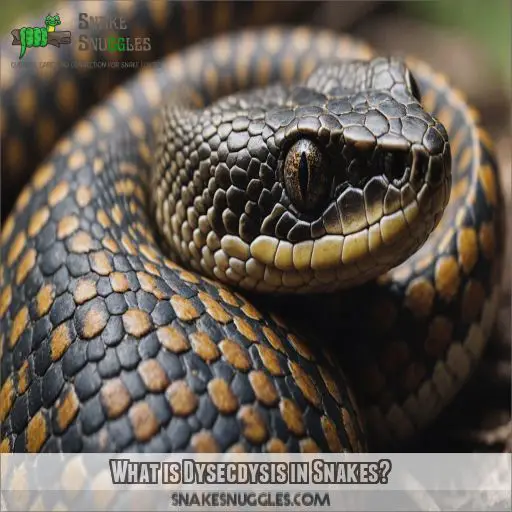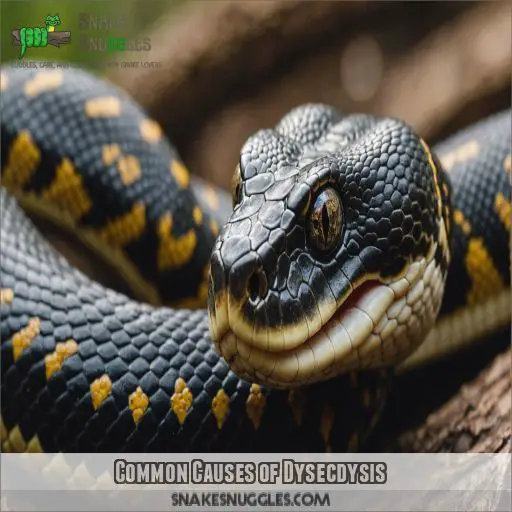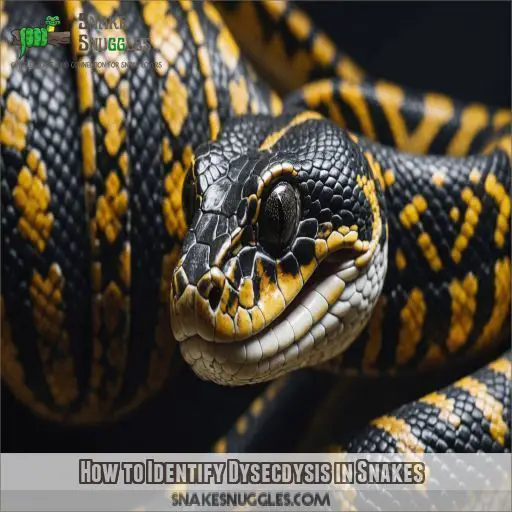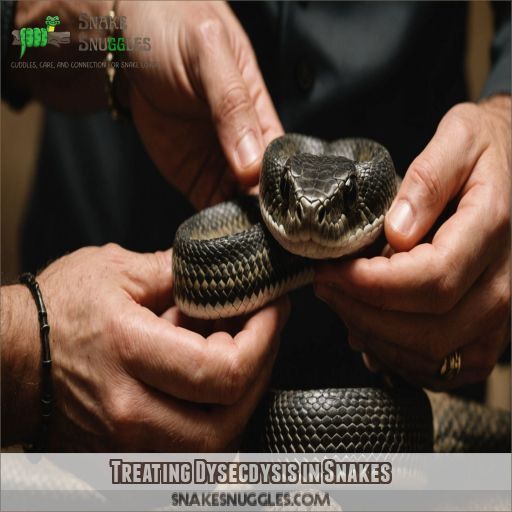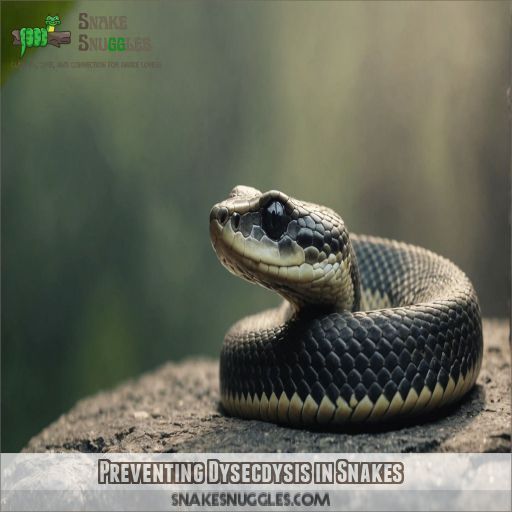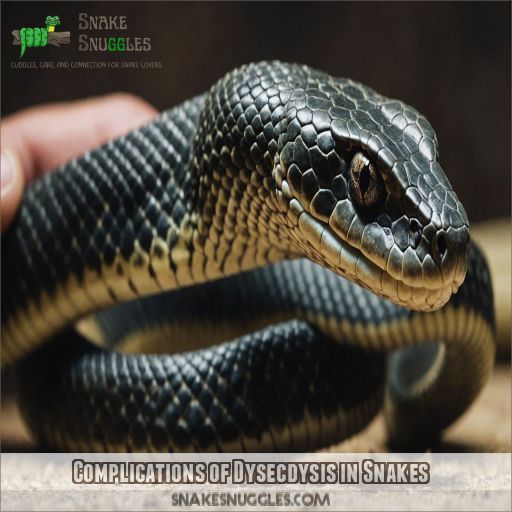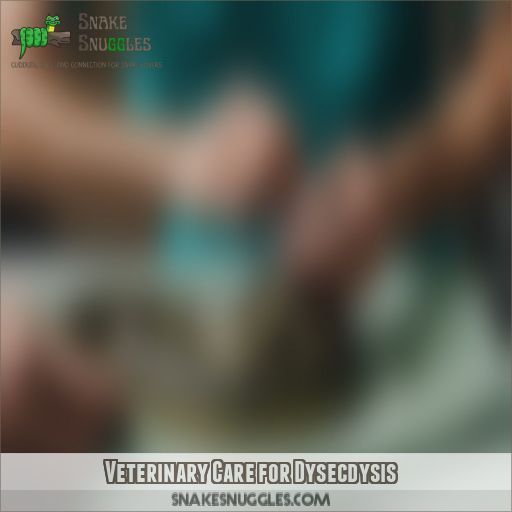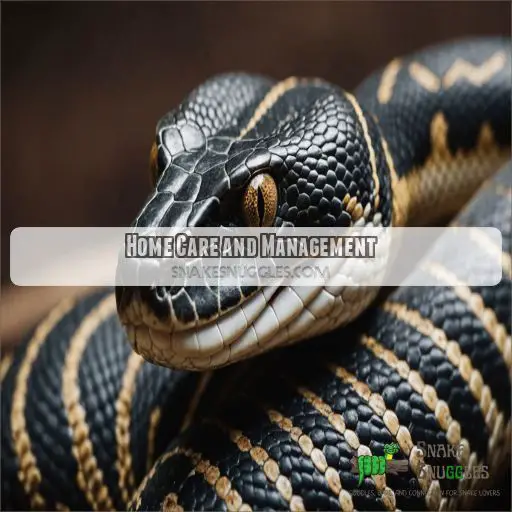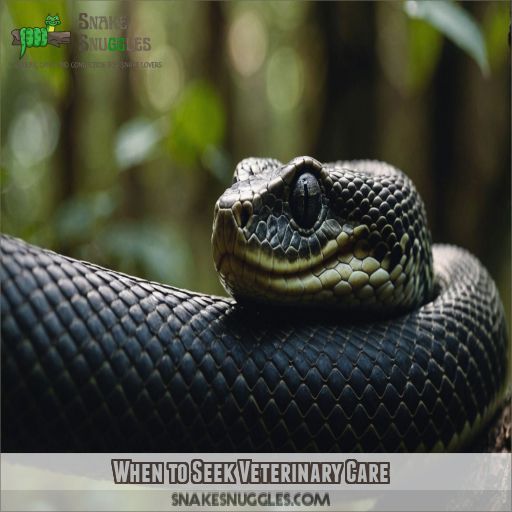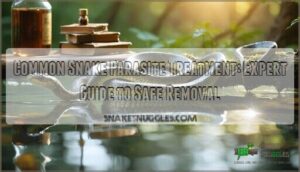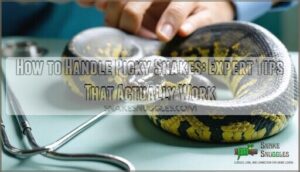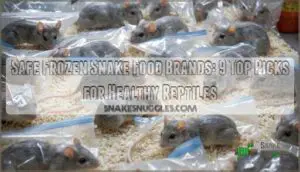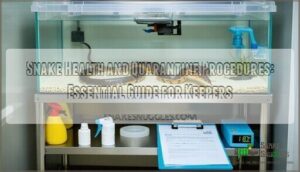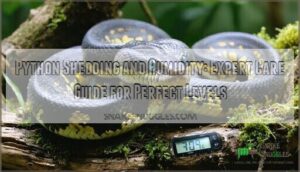This site is supported by our readers. We may earn a commission, at no cost to you, if you purchase through links.
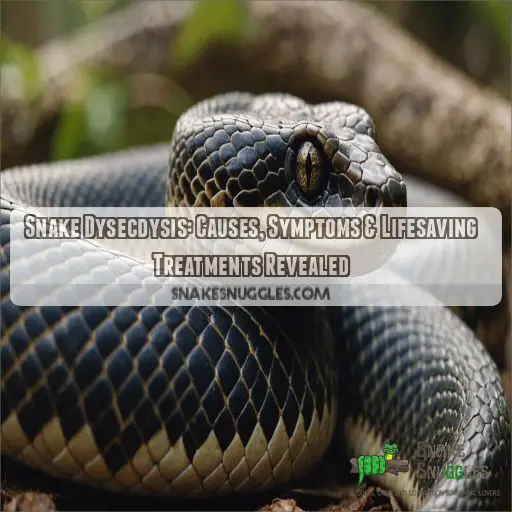 Don’t panic if your snake has dysecdysis! This shedding issue is common and often fixable.
Don’t panic if your snake has dysecdysis! This shedding issue is common and often fixable.
Your scaly friend’s stuck shed could be due to low humidity, a poor diet, or stress.
Look for signs like dull skin, retained eye caps, or incomplete shedding.
To help, boost humidity with a misting system or humid hide.
Soak your snake in warm water for 15-20 minutes, then gently assist with shedding using a damp cloth.
Avoid force – you’re not peeling a banana!
If problems persist, consult a reptile vet.
Ready to learn more about snake skincare?
Table Of Contents
- Key Takeaways
- What is Dysecdysis in Snakes?
- Common Causes of Dysecdysis
- How to Identify Dysecdysis in Snakes
- Treating Dysecdysis in Snakes
- Preventing Dysecdysis in Snakes
- Complications of Dysecdysis in Snakes
- Veterinary Care for Dysecdysis
- Home Care and Management
- When to Seek Veterinary Care
- Frequently Asked Questions (FAQs)
- How do you treat dysecdysis in snakes?
- What is the most likely cause of dysecdysis?
- What are the symptoms of dysecdysis?
- What to do if your snake is having trouble shedding?
- How long does dysecdysis typically last in snakes?
- Can dysecdysis affect a snakes behavior or appetite?
- Are certain snake species more prone to dysecdysis?
- Is dysecdysis contagious between snakes in shared enclosures?
- Can dysecdysis recur after successful treatment?
- Conclusion
Key Takeaways
- You’re not peeling a banana, so don’t force it! Dysecdysis is like your snake being stuck in a too-tight sweater. Boost humidity, provide a warm soak, and gently assist with shedding using a damp cloth. If your scaly friend is still struggling, it’s time to call in the reptile experts.
- Keep your snake’s enclosure in tip-top shape! Poor husbandry is the number one culprit behind shedding woes. Nail the perfect humidity and temperature combination, and you’ll be helping your snake slip into its new skin like it’s trying on a designer outfit.
- Be a snake detective! Look out for dull, patchy skin, cloudy eyes, and excessive rubbing. These are your snake’s SOS signals. Remember, 90% of dysecdysis cases stem from environmental issues, so put on your Sherlock hat and investigate those enclosure conditions.
- Don’t let your snake become a repeat offender! Dysecdysis can be a recurring nightmare if you don’t address the root causes. Maintain proper humidity, serve up a balanced diet, and create a stress-free environment. Your reptilian friend will thank you by shedding like a pro.
What is Dysecdysis in Snakes?
You’re probably worried sick about your snake’s dysecdysis, and rightly so.
Dysecdysis is a condition where your snake’s skin doesn’t shed properly, often due to environmental or nutritional issues.
Addressing the causes and symptoms is key to providing the right treatment and preventing further problems.
Definition and Explanation
Here’s the lowdown on snake dysecdysis: it’s a fancy term for a shedding gone wrong. Normally, snakes renew their skin through ecdysis, a process where they molt in one piece. But when things get stuck, literally, it’s dysecdysis. Think of it like a skin-tight suit that won’t budge – not fun for your slithery friend!
Causes of Dysecdysis
Now that you know what dysecdysis is, let’s explore what causes it. It’s not just one thing, but a combination of factors that can lead to shedding problems in snakes. Here are four common culprits:
- Environmental Stress: Poor temperature, humidity, and lighting can stress your snake, causing shedding issues.
- Poor Hygiene: A dirty enclosure can lead to skin infections and dysecdysis.
- Skin Trauma: Handling your snake too much or incorrectly can cause skin damage and shedding problems.
- Parasite Infestation: Internal parasites can weaken your snake’s immune system, making it more prone to dysecdysis.
Symptoms and Signs of Dysecdysis
| Symptoms | Description |
|---|---|
| Skin Discoloration | Dull, dry, or wrinkled skin |
| Eye Problems | Swelling, discharge, or retained eye caps |
| Behavioral Changes | Lethargy, loss of appetite, or stress |
Keep an eye out for these signs to catch dysecdysis early!
Common Causes of Dysecdysis
You’re dealing with a snake that has dysecdysis, and it’s important to figure out what’s causing it so you can give the right treatment.
Common causes of dysecdysis include:
- Poor husbandry and management
- Inadequate humidity and temperature
- Nutritional deficiencies
- Handling snakes during shedding
- Retained skin and eye caps
- Incomplete shedding
- Skin lesions
- Behavioral changes and stress
All of these factors can contribute to this condition (Source).
Poor Husbandry and Management
Poor husbandry and management can lead to dysecdysis. Check your snake’s enclosure size, substrate type, and water availability to prevent shedding issues.
Inadequate Humidity and Temperature
Now, let’s talk temperature and humidity – two important factors that can make or break your snake’s shedding process, and even lead to dysecdysis.
Nutritional Deficiencies and Malnutrition
Poor nutrition can lead to dysecdysis, so provide a balanced diet rich in calcium, vitamins, and protein to keep your snake healthy.
Handling Snakes During Shedding
When handling snakes during shedding, use gentle touch to avoid skin damage. Here are best practices to prevent dysecdysis:
- Avoid handling during peak shedding, as stress can cause skin tears.
- Support their body, letting them move freely to reduce pressure on shedding skin.
- Use a hook or tongs to gently guide them, rather than bare hands.
- Minimize handling time to prevent prolonged stress and skin damage.
Retained Skin and Eye Caps
Retained skin and eye caps can be a major issue for your snake, risking eye damage and blindness – take prevention seriously!
Incomplete Shedding and Dysecdysis
Now that you know about retained skin and eye caps, let’s tackle incomplete shedding, another common cause of dysecdysis in snakes, head-on.
Skin Lesions and Infections
You’ll want to watch out for skin lesions and infections, which can cause dysecdysis, including bacterial dermatitis and fungal infections.
Behavioral Changes and Stress
Your snake’s stress can cause dysecdysis! Identify stress indicators and anxiety triggers to manage environmental stressors and prevent this condition.
- Temperature fluctuations: Avoid placing sizzle stones near heat sources, causing thermal stress.
- Lack of hiding places: Provide sufficient visual barriers to reduce anxiety.
- Incorrect humidity: Maintain proper humidity levels to prevent dehydration stress.
How to Identify Dysecdysis in Snakes
You’re worried your snake has dysecdysis, and you want to know how to identify it – let’s get straight to the point. By learning the visual cues and behavioral changes that signal dysecdysis, you can quickly spot the problem and take action to prevent complications and get your snake back on track.
Visual Inspection and Observation
Now that you know the common causes of dysecdysis, it’s time to get up close and personal with your snake. Perform a visual inspection, looking for signs of abnormal shedding, skin lesions, or eye problems. Check for retained skin or eye caps, and observe your snake’s overall demeanor. This will help you identify potential issues early on.
Monitoring Shedding Patterns and Behavior
Monitoring your snake’s shedding patterns and behavior is vital to identifying dysecdysis. You’ll want to keep an eye on their shedding cycle, inspect their skin, and observe any changes in behavior. Think of it as being a snake detective!
- Keep a shedding journal to track patterns and changes
- Inspect their skin for signs of dryness or irritation
- Monitor humidity levels to verify they’re within range
- Watch for changes in appetite or activity levels
- Take note of any skin lesions or discoloration
Recognizing Abnormal Shedding and Dysecdysis
When your snake sheds, it’s like a mini-makeover! But if the shedding cycle goes awry, it’s a red flag. Look out for Dysecdysis warning signs: retained skin, eye caps, or irregular shedding frequency. Environmental factors can impact snake skin health, so monitor temperature and humidity levels. Don’t ignore these shedding cycle issues – your snake’s health depends on it!
Treating Dysecdysis in Snakes
You’ve identified dysecdysis in your snake, and now it’s time to take action – with the right treatment, you can help your pet recover and prevent future shedding problems. In this section, we’ll walk you through the steps to treat dysecdysis in snakes, from providing a humid environment to gentle removal of dead skin and eye caps.
Providing a Humid Environment and Soaking
Create a humid hide setup to help your snake shed smoothly. Monitor humidity levels and adjust as needed. Soaking techniques can also aid in shedding – simply place your snake in a shallow water bowl for a relaxing soak.
Gentle Removal of Dead Skin and Eye Caps
Gently removing dead skin and eye caps requires finesse. You’ll want to soak your snake in a warm bath to loosen the skin, then carefully remove it with a damp cloth or shedding aid tool. Be patient and gentle to avoid causing stress or injury.
- Soak your snake in a warm bath (around 80-85°F) for 10-15 minutes to loosen the dead skin.
- Use a damp cloth or shedding aid tool to gently remove the dead skin, working from head to tail.
- For stuck eye caps, try soaking the snake’s head in a small bowl of warm water or using a cotton swab to gently loosen the cap.
- If the skin or eye cap doesn’t come off easily, don’t force it – consult a veterinarian for guidance.
Antibiotic Treatment for Infections
Now that you’ve gently removed dead skin and eye caps, it’s time to tackle any underlying infections. Your veterinarian may prescribe antibiotics to combat common infections. Be sure to follow dosage guidelines carefully to avoid antibiotic resistance and minimize side effects.
Nutritional Support and Supplements
Now that your snake is on the mend with antibiotics, it’s time to boost their nutrition! You’ll want to make sure they get all the nutrients they need to recover, including proper calcium levels, and support gut health. A pre-shed diet and supplements can work wonders.
- Give your snake a nutrient-rich diet to fight off infection
- Calcium and vitamin D3 supplements support strong bones and shedding
- Probiotics promote a healthy gut, because a happy gut = a happy snake
- Omega-3 fatty acids reduce inflammation and support skin health
- A pre-shed diet helps your snake prepare for a successful shed
Preventing Dysecdysis in Snakes
You’ve already had to deal with the stress of dysecdysis in your snake, so now it’s time to learn how to prevent it from happening again in the future. By making a few simple changes to your snake’s environment and care routine, you can greatly reduce the risk of dysecdysis and keep your pet healthy and happy.
Maintaining Proper Humidity and Temperature
Keeping the right humidity and temperature is really important to prevent dysecdysis in snakes. You’ll want to create a temperature gradient and maintain good humidity levels. Here’s a handy guide to get you started:
| Environmental Factor | Recommended Range | Monitoring Device |
|---|---|---|
| Temperature | 75-85F (24-29C) | Thermometer |
| Humidity | 30-50% | Hygrometer |
| Heat Source | Heat lamp or ceramic heat emitter | Thermometer |
| Enclosure Ventilation | Adequate airflow | Ventilation gauge |
Providing a Balanced and Nutritious Diet
To prevent dysecdysis in your snake, focus on providing a balanced and nutritious diet. Mix it up with a variety of prey items, and consider calcium supplements to support their growing bones. Feed them at the right frequency, taking into account their age, size, and species-specific needs. A well-fed snake is a happy, healthy snake!
Avoiding Handling Snakes During Shedding
When your snake’s shedding, it’s important to give them space. Handling can cause stress, leading to skin damage and dysecdysis. Avoid touching or holding your snake during this sensitive time. Let them complete their shedding cycle in peace. By doing so, you’ll help prevent complications and keep your snake healthy and happy.
Complications of Dysecdysis in Snakes
As you navigate the challenges of dysecdysis in your snake, you need to be aware of the potential complications that can arise if left untreated or not managed properly.
From skin infections and lesions to eye damage, respiratory problems, and even systemic infections, understanding these risks will help you take prompt action and seek veterinary care.
This will help prevent long-term harm to your pet.
Skin Infections and Lesions
Skin infections and lesions are nasty complications of dysecdysis. If you notice redness, swelling, or discharge, seek a reptile specialist ASAP. Causes of lesions include bacteria, fungi, or parasites. Prevention tips: maintain a clean environment, provide proper humidity, and avoid handling during shedding.
Eye Damage and Blindness
You’re dealing with a snake’s eye damage and blindness due to dysecdysis. Don’t panic! With proper care, your snake can recover. Gently remove retained eye caps, and provide a humid environment to prevent further complications.
- Eye care is very important during shedding issues to prevent vision loss
- A blind snake can still thrive with proper adaptations and care
- Retained caps can cause permanent damage if not removed promptly
- Regular check-ups with a veterinarian can help prevent and treat eye problems
Respiratory Problems and Pneumonia
When your snake’s dysecdysis takes a turn for the worse, respiratory problems and pneumonia can set in. Watch for labored breathing, wheezing, or mucus discharge. Get your snake to a vet ASAP for antibiotics and oxygen therapy to prevent a fatal outcome.
Systemic Infections and Sepsis
You’re dealing with systemic infections and sepsis – a life-threatening complication of dysecdysis in snakes. Don’t panic! Keep an eye out for:
- Lethargy and loss of appetite
- Swelling and redness around the infected area
- Discharge or pus oozing from the wound
Veterinary Care for Dysecdysis
If your snake has dysecdysis, you need to see a vet right away to avoid any more problems and make sure your pet gets the right treatment. A reptile-savvy vet will check your snake, figure out what’s causing the dysecdysis, and create a treatment plan that’s just for your snake to get them back on track.
Examination and Diagnosis
When you take your snake to the vet, they’ll perform a visual inspection, examining shedding patterns, skin lesions, and abnormal behavior. They’ll search for underlying causes, like poor husbandry, malnutrition, or infections. Your vet’s goal is to diagnose and help your snake.
| Common Signs of Dysecdysis | Underlying Causes |
|---|---|
| Abnormal shedding patterns | Poor husbandry, temperature fluctuations |
| Skin lesions, wounds | Malnutrition, bacterial or fungal infections |
| Changes in behavior, lethargy | Stress, dehydration, or underlying diseases |
| Retained skin or eye caps | Inadequate humidity, handling during shedding |
Treatment and Management
Now that your vet has diagnosed dysecdysis, it’s time for treatment. They’ll likely recommend a humidity boost, antibiotics if there’s an infection, and supportive care like nutritional supplements. Your vet may also show you some safe home remedies to help your snake recover comfortably.
Follow-up Care and Monitoring
After treatment, it’s vital to monitor your snake’s skin condition, hydration levels, and appetite changes closely. Keep a close eye on enclosure hygiene and watch for any behavioral changes. Regular follow-up visits with your vet will guarantee your snake’s smooth recovery.
Referral to a Specialist
If your snake’s dysecdysis worsens or doesn’t improve, it’s time to seek specialist care. Here are your options:
- Reptile Vet Referral: Ask your vet for a referral to a herpetology expert.
- Specialist Treatment Plans: Look for a specialist with experience in treating snake dysecdysis.
- Herpetology Expert Care: Don’t settle for anything less than expert care for your pet snake.
Home Care and Management
Now that your snake has received veterinary care, it’s time to focus on home care and management.
Make environmental adjustments to facilitate a smooth recovery. Maintain a humid environment and control the temperature to aid in shedding.
Practice good skin care by gently removing dead skin and providing a shallow dish of lukewarm water for soaking.
Offer nutritional support with a balanced diet, and consider supplements if recommended by your vet.
With proper care, your snake will be slithering back to health in no time.
When to Seek Veterinary Care
If your snake has dysecdysis, it’s imperative to know when to seek veterinary care to prevent severe complications. You should rush to the vet if you notice severe symptoms, suspect an underlying infection or systemic disease, or if your snake fails to improve with treatment – trust us, your snake’s life depends on it!
Severe Symptoms and Complications
If your snake’s dysecdysis takes a turn for the worse, don’t hesitate to seek veterinary care. Severe symptoms like respiratory distress, eye infections, or skin necrosis require immediate attention. Delaying treatment can lead to organ damage or chronic health issues. Your vet will provide a proper diagnosis and treatment plan to get your snake back on track.
Infections and Systemic Diseases
If your snake’s shedding woes are accompanied by unusual symptoms, it’s time to call the vet.
Keep an eye out for fungal growths (think moldy bread on scales), bacterial infections (angry red patches), or parasites hitching a ride.
Viral diseases and immune disorders can also crash the party.
Failure to Improve With Treatment
If your snake isn’t shedding properly after treatment, it’s time to seek professional help.
There could be underlying health issues or secondary infections at play.
Perhaps the initial diagnosis was incorrect, or your snake needs a different treatment approach.
Don’t let the problem linger; a vet visit could be the key to finding long-term care solutions and getting your snake back to health.
Frequently Asked Questions (FAQs)
How do you treat dysecdysis in snakes?
To treat dysecdysis, you’ll need to boost humidity and provide a warm soak. Gently rub the stuck skin with a damp cloth, but don’t pull! If it persists, consult a reptile vet. They’re the real snake charmers!
What is the most likely cause of dysecdysis?
The most likely culprit behind your scaly friend’s shedding woes? Poor husbandry, hands down. You’re probably not nailing the humidity or temperature sweet spot. It’s like giving your snake a bad hair day, every day!
What are the symptoms of dysecdysis?
Did you know 90% of dysecdysis cases stem from poor husbandry? You’ll notice your snake’s skin looking dull, patchy, or stuck. Its eyes might appear cloudy, and it’ll rub against objects more than usual. Keep an eye out!
What to do if your snake is having trouble shedding?
If your scaly buddy’s having a tough shed, don’t panic! Boost humidity with a mist or soak, offer rough surfaces for rubbing, and avoid handling. If problems persist, consult a reptile vet for expert guidance.
How long does dysecdysis typically last in snakes?
Dysecdysis in snakes can last anywhere from a few days to several weeks. You’ll want to keep a close eye on your scaly friend during this time. It’s like they’re struggling to wriggle out of a too-tight sweater!
Can dysecdysis affect a snakes behavior or appetite?
Picture a snake trapped in an itchy sweater it can’t remove. That’s dysecdysis. It’ll affect your snake’s behavior and appetite. You’ll notice restlessness, decreased eating, and increased rubbing. Address it promptly to keep your scaly friend comfortable and healthy.
Are certain snake species more prone to dysecdysis?
While all snakes can experience dysecdysis, some species are more susceptible. You’ll find that tropical species, like ball pythons and boas, often struggle in dry environments. Keep an eye on your scaly friend’s humidity levels to prevent shedding woes.
Is dysecdysis contagious between snakes in shared enclosures?
Don’t worry, dysecdysis isn’t contagious between snakes. It’s usually caused by environmental factors or health issues specific to each snake. However, if multiple snakes have shedding problems, you’ll want to check your husbandry practices for any issues.
Can dysecdysis recur after successful treatment?
In a heartbeat, dysecdysis can resurface! You’ll want to keep a watchful eye on your scaly friend. It’s not set in stone, but maintaining proper humidity and nutrition can help prevent future shedding issues. Stay vigilant!
Conclusion
Just as a snake sheds its skin to grow, you can shed your worries about dysecdysis with the right knowledge and care.
By maintaining proper humidity, providing a balanced diet, and creating a stress-free environment, you’ll help your scaly friend shed like a pro.
Don’t hesitate to consult a reptile vet if issues persist.
With patience and attention, you’ll make sure your snake stays healthy, happy, and looking its best.

